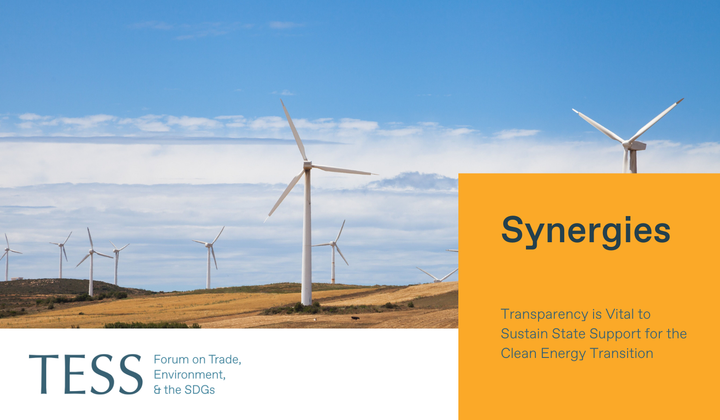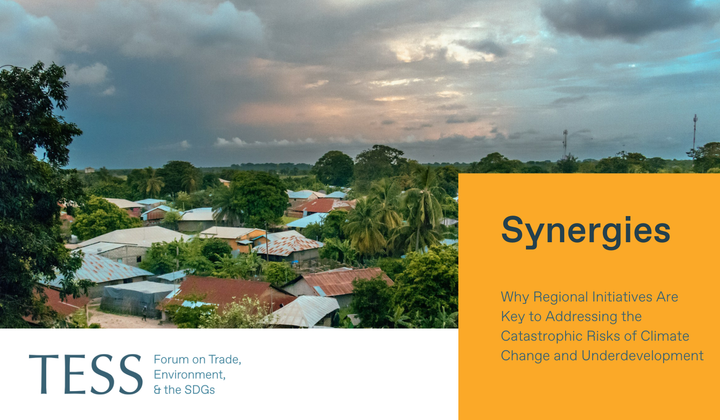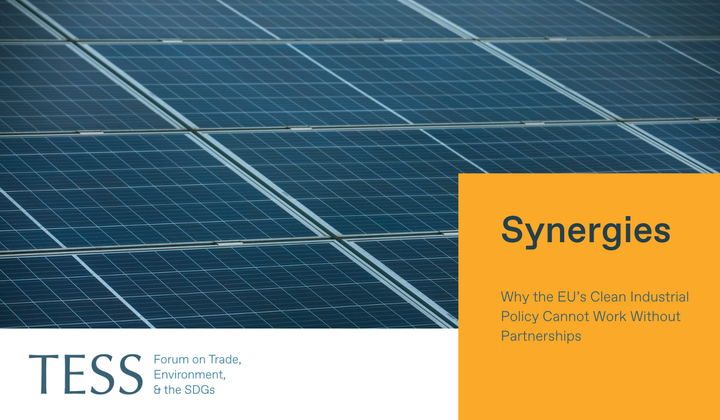Major economies are adopting more interventionist green industrial policies to accelerate decarbonization and reshape production. While these tools can drive rapid change, their current design in several jurisdictions risks excluding emerging markets and developing economies by prioritizing domestic competitiveness and security over global fairness, mutual benefit, and ultimately reaching the goals of the Paris Agreement. This article outlines four complementary categories of measures to better align national industrial strategies with globally shared climate and development goals.
This article is part of a Synergies series on climate and trade curated by TESS titled Addressing the Climate Crisis and Supporting Climate-Resilient Development: Where Can the Trading System Contribute? Any views and opinions expressed are those of the author(s) and do not necessarily reflect those of TESS or any of its partner organizations or funders.
-----

Recent policy developments in major economies—high-income countries and large emerging economies—mark a shift in climate policy with the state playing a more interventionist role to drive economic transformation related to energy transitions. Instruments such as subsidies, procurement policies, and clean technology incentives—long part of governments’ toolkits—are now playing a more economically significant and strategic role alongside market mechanisms such as carbon taxes and emissions trading schemes. Together with the increasing use of local content and manufacturing provisions for energy transition technologies and the adoption of policy tools such as the European Union’s Carbon Border Adjustment Mechanism (CBAM), it is fair to say that there is a broader trend towards green industrial policies.
While green industrial policies can be powerful drivers of decarbonization and are used by countries in all regions, the way they are currently designed in several major economies carries risks of leaving emerging market and developing economies (EMDEs) behind. In many cases, these policies are focused on domestic benefits, framed through the lens of industrial competitiveness and economic and geopolitical security. Although these aims are a justifiable part of garnering domestic support for energy transition investment, there is real concern that current approaches are insufficiently aligned with principles of global fairness, mutual benefit, and coherence with global climate targets. Such coherence entails ensuring that all regions decarbonize in line with the Paris Agreement goals, avoiding a future in which EMDEs—expected to see the fastest economic growth—are steered towards more carbon-intensive pathways due to limited access to finance, technology, or markets.
Without deliberate measures to make green industrial policies in major economies more inclusive, there is a danger of entrenching a “two-speed” transition in which more advanced and large economies surge ahead while other EMDEs face barriers to inclusion in new green value chains and the adoption of energy transition technologies. At the same time, for EMDEs to actively engage, the energy transition must deliver tangible economic and social benefits, addressing their development priorities alongside emissions reductions.
Ensuring that green industrial policies align with inclusive development and climate goals calls for creating pathways for technology transfer, joint innovation, fair integration into green value chains, and significantly scaled-up international climate finance for industrial development. It also calls for trade policies and standards that enable broad participation, and for high-level political commitments on cooperation to be anchored in operational collaboration between governments, industry, and research institutions across economies at all income levels.
Pathways Forward
A recent Stockholm Environment Institute (SEI) report examines a number of proposals for how green industrial policies in major economies can be designed and implemented to better support inclusive energy and industrial transitions in EMDEs. Drawing on published policy research and analysis, workshops organized by the Leadership Group for Industry Transition (LeadIT) in September 2024 and March 2025, and interviews with representatives from EMDEs, the SEI report identifies potential approaches for aligning green industrial policy with EMDE development priorities and climate goals
Ensuring Technology Access, Technical Cooperation, and Capacity Building
A focused strategy on green technology transfer and co-development should be a priority, with agreements that move beyond access towards strategic partnerships. This can include flexible and development-oriented intellectual property arrangements, co-innovation/co-development of locally tailored technologies, and green technology diffusion funding. Embedding co-development and industrial cooperation objectives in trade and strategic partnership agreements and funding joint calls for proposals between partner countries through bilateral programmes and multilateral facilities are two avenues for implementation.
Another idea is to link domestic financial support for green technologies to commitments to provide technology, preferential licensing, and expertise to companies in EMDEs. In partnership with international organizations, major economies could also invest in local innovation hubs, technology incubators, and training on technical skills, management, and environmental standards. The UN Technology Bank for Least Developed Countries illustrates this approach through needs assessments, technology-transfer partnerships, and targeted training.
Trade and strategic partnership agreements could include R&D collaboration clauses and expanded joint funding connecting universities, research institutions, and companies across economies. Joint venture promotion platforms such as India–Sweden’s Industry Transition Partnership under LeadIT, the Brazil–UK Industrial Decarbonisation Hub, the Climate Club’s Global Matchmaking Platform, and the Mission Possible Partnership’s Industrial Transition Accelerator are examples of efforts to facilitate this type of cooperation. Expanding industry transition partnerships to new country pairs and sectors offers a practical way to operationalize inclusive industrial decarbonization.
Equitable Integration Into Green Value Chains
To prevent a green technology divide, EMDEs should be more fully integrated into global value chains for energy transition materials and technologies in ways that promote local value addition and build industrial capabilities, particularly in areas that align with local strengths. Relocating energy-intensive production to regions with abundant renewable resources—e.g. producing green hydrogen to make low-emission iron/steel or ammonia—enables EMDEs to export climate benefits. Where domestic value addition is less feasible, countries must receive fair compensation for supplying critical materials or energy resources, enabling them to channel revenues into infrastructure, education, and broader economic diversification. Major economies, in turn, must strike a balance between competitiveness and security concerns and the diffusion of green technologies across regions to meet global climate and development targets. The EU’s new clean trade and investment partnerships instrument offers a clear opportunity to put into practice such an approach.
Increasing International Climate Finance
Effective finance is pivotal. Alongside domestic investments, major economies should expand financing for green technology adoption and green industrialization in EMDEs. The Climate Investment Funds’ (CIF) $1 billion Industry Decarbonization Program is a pioneering example, supporting middle-income countries to decarbonize heavy industry. For every dollar it puts in, CIF hopes to attract 12 dollars from development banks and private investors.
Co-innovation and green technology diffusion funds could be financed by international climate finance, multilateral development banks, and, as some have suggested, through recycling revenues from carbon-related border measures, such as the EU’s CBAM, to EMDEs for green energy and industrial investments. Given high debt burdens, others have argued for linking debt relief to climate transition investments. Germany, for example, already employs a debt-for-climate swaps programme.
Inclusive and Sustainable Trade Framework
While national strategies must secure domestic benefits, trade and partnership frameworks should also promote the international diffusion of clean technologies, as noted, and enable EMDEs to pursue their development and industrialization objectives. Improving coherence between domestic market-supporting measures and inclusive trade conditions could involve designing climate-related trade instruments and standards that facilitate market participation by EMDEs, for example through differentiated and achievable standards. Funded technical assistance and capacity building is also needed to help partners meet evolving climate and trade requirements and align domestic policies, while standards must be transparent and efficient, avoiding discriminatory barriers; including through mutual recognition and harmonization to help reduce burdens.
Looking Ahead
Green industrial policy is increasingly shaping decarbonization efforts by major economies. A central challenge is aligning national priorities of competitiveness, security, and employment alongside opportunities for clean technologies, value addition, and capabilities across regions in line with the Paris Agreement goals. This ultimate objective cannot be reached through a zero-sum race for green industries that could result in a two-speed transition, but rather through a mutually beneficial transition that expands opportunity, lowers global abatement costs, and makes better use of comparative advantages. Looking forward, greater efforts are needed to operationalize mutually beneficial partnerships, scale finance, and design inclusive standards and trade instruments that enable EMDE participation and local value addition while preserving environmental integrity and cooperation towards shared climate and development goals.
* This post is derived from the Stockholm Environment Institute’s recently published report on Green industrial policy: Challenges and opportunities fora globally inclusive and fair energy transition.
----------
Aaron Maltais, PhD, is a Senior Research Fellow at the Stockholm Environment Institute and Acting Team Lead for the Energy and Industry Transitions Team. He also works on policy, finance, and analysis for the Secretariat for the Leadership Group for Industry Transition (LeadIT).
Tim Suljada is Head of Division – Resources, Rights and Development at the Stockholm Environment Institute.
-----
Synergies by TESS is a blog dedicated to promoting inclusive policy dialogue at the intersection of trade, environment, and sustainable development, drawing on perspectives from a range of experts from around the globe. The editor is Fabrice Lehmann.
Disclaimer
Any views and opinions expressed on Synergies are those of the author(s) and do not necessarily reflect those of TESS or any of its partner organizations or funders.
License
All of the content on Synergies is licensed under a Creative Commons Attribution-NonCommercial-ShareAlike 4.0 International (CC BY-NC-SA 4.0) license. This means you are welcome to adapt, copy, and share it on your platforms with attribution to the source and author(s), but not for commercial purposes. You must also share it under the same CC BY-NC-SA 4.0 license.
If you would like to reuse any material published here or if you have any other question related to Synergies, send an email to fabrice.lehmann@graduateinstitute.ch.





